

EdPractices 19. Edutopia. A simple visual accompanied by a short, succinct prompt. Not every math standard boils down to such a visual though, so often I use mathematical models, patterns, or matching exercises to catch kids’ attention. The idea of the hook is to allow students to investigate the concepts within the daily lesson in a straightforward manner through a low-floor, high-ceiling problem that generates conversation. Sometimes there is no visual component. Why do people get so anxious about math? - Orly Rubinsten. Still wondering how you can improve your math skills?
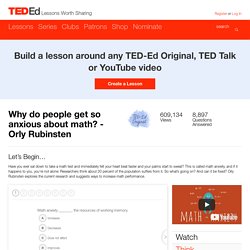
This TEDx Talk by Jo Boaler and this article will provide some ideas for you and might just change your outlook. We still have a lot to learn about the human brain. This site: Changing Brains has many resources and tons of interesting information about brain development. Learn about the many women in mathematics here. Next, meet Maryam Mirzakhani, the first woman to win the highest math honor in the world. For Teachers Who Dread Math, Finding a Better Way. How 'Productive Failure' In Math Class Helps Make Lessons Stick. Getting Started – Becoming the Math Teacher You Wish You'd Had. Welcome to the companion website for Becoming the Math Teacher You Wish You’d Had: Ideas and Strategies from Vibrant Classrooms.
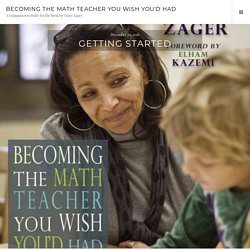
As you poke around, you’ll find one page for each chapter. On each page, you’ll find a variety of links, related blogposts, articles, videos, and other supplementary resources. Becoming the Math Teacher You Wish You'd Had. While mathematicians describe mathematics as playful, beautiful, creative, and captivating, many students describe math class as boring, stressful, useless, and humiliating.

In Becoming the Math Teacher You Wish You’d Had, Tracy Zager helps teachers close this gap by making math class more like mathematics. Tracy spent years with highly skilled math teachers in a diverse range of settings and grades. You’ll find this book jam-packed with new thinking from these vibrant classro...read more Tracy spent years with highly skilled math teachers in a diverse range of settings and grades.
The-school-teaching-students-that-its-ok-to-fail-20170827-gy4zo1. Open-Ended Tasks and Questions in Mathematics. One way to differentiate in math class is creating open-ended tasks and questions (I talked about several differentiation strategies I use here – Mathematically Speaking).

I think it is useful to clarify the scheme of mathematical problems – below I used Foong Pui’s research paper: “Problems in this classification scheme have their different roles in mathematics instruction as in teaching for problem solving, teaching about problem solving, or teaching via problem solving.” 1. CLOSED problems are well-structured problems in terms of clearly formulated tasks where the one correct answer can always be determined in some fixed ways from the necessary data given in the problem situation. A.Routine closed problems – are usually multi-step challenging problems that require the use of a specific procedure to arrive to the correct, unique, answer. B. *Problem-solving heuristics: work systematically, tabulate the data, try simpler examples, look for a pattern, generalize a rule etc. Encouraging Student Self-Reflection. As part of my school’s PBIS behavior management system, students have the opportunity to earn “tokens” they can save and redeem for rewards.

A student favorite is the Stinky Feet pass, which allows students to work in the classroom with their shoes off for the day. Teachers can give students a Rocket Buck when they observe behavior that is consistent with the school expectations. As an intervention teacher, I like to be able to reward my students, but I also want the reward to be meaningful. Theconversation. Despite decades of reform efforts, mathematics teaching in the U.S. has changed little in the last century.
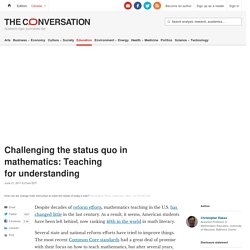
As a result, it seems, American students have been left behind, now ranking 40th in the world in math literacy. Several state and national reform efforts have tried to improve things. The most recent Common Core standards had a great deal of promise with their focus on how to teach mathematics, but after several years, changes in teaching practices have been minimal. As an education researcher, I’ve observed teachers trying to implement reforms – often with limited success.
They sometimes make changes that are more cosmetic than substantive (e.g., more student discussion and group activity), while failing to get at the heart of the matter: What does it truly mean to teach and learn mathematics? Traditional mathematics teaching. Strategies for Helping Students Motivate Themselves.
My previous post reviewed research on extrinsic and intrinsic motivation, and described the four qualities that have been identified as critical to helping students motivate themselves: autonomy, competence, relatedness, and relevance. In this post, I’ll discuss practical classroom strategies to reinforce each of these four qualities. Autonomy Providing students with freedom of choice is one strategy for promoting learner autonomy. Educators commonly view this idea of choice through the lens of organizational and procedural choice. What's Going on Inside the Brain Of A Curious Child? How Kids Benefit From Learning To Explain Their Math Thinking. Math teachers of older students sometimes struggle to get students to explain their thinking with evidence. ASKING STUDENTS TO CHOOSE A PATH AND JUSTIFY IT. Curiosity Is a Unique Marker of Academic Success.
Curiously (pun intended), curiosity is also virtually absent from the field of gifted-and-talented education.
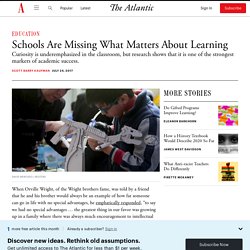
A recent survey of required identification methods across all states found that only three considered motivation a part of giftedness. IQ, on the other hand, is required by 45 states, while 39 require standardized tests of achievement. A recent feature story in Scientific American further punctuates this point. CuriosityPPKeynoteSlides2012.
3 Act Math – When Math Happens. The 3 Act Math format was developed by Dan Meyer.
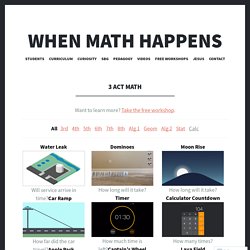
See the links below. Explanation Post Modeled Lesson Dan’s Lessons 5 Practices. Edutopia. How long do you think teachers pause, on average, after asking a question? Several studies from the 1970s on have looked into the effect that the amount of time teachers pause after asking a question has on learners. In visiting many classrooms in the United States and other parts of the world, I’ve found that, with few exceptions, these studies are still accurate. For example, according to work done by Mary Budd Rowe in 1972 and Robert J. Maths Books Ideas. Bedtime Maths App. Chn's Lit and Maths. Modeling With Mathematics. Shifting the Grading Mindset Starts With Our Words - Work in Progress. Language matters.
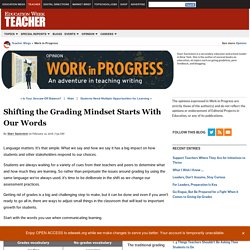
It's that simple. What we say and how we say it has a big impact on how students and other stakeholders respond to our choices. Five Ways to Sustain School Change Through Pushback, Struggle and Fatigue.
EDMA410 Maths Writing. Edutopia. Maths world and real world times tables. Teaching Math to Spark Creative Thinking. Now Playing Teaching Math to Spark Creative Thinking One Harlem charter school gets creative with problem solving.

You’re all ‘math people,’ but you just didn’t know it. 2 WAYS TO TEACH AND LEARN MATHS - A Learning Place A Teaching Place. Richard R Skemp believed that children could learn intelligently from a young age. Edutopia. Edutopia. Performance-Based Assessment: Making Math Relevant. Why Kids Need to Move, Touch and Experience to Learn. No grades, no timetable: Berlin school turns teaching upside down. Could subjects soon be a thing of the past in Finland? Carol Dweck: The power of believing that you can improve. Kids Don’t Fail, Schools Fail Kids: Sir Ken Robinson on the ‘Learning Revolution’ Fact Fluency Is More Important Than Memorization for Multiplication. A non-teacher friend recently mentioned how, as a kid, he had really loved math class until the fourth grade.
The difference between instrumental and relational understanding – The Reflective Educator. Raising Kids With Grit: You're Probably Doing It Wrong.